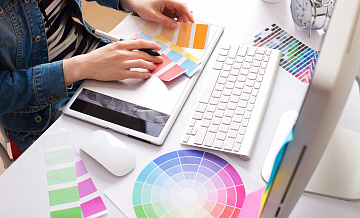The Art and Craft of a Graphic Designer: Transforming Ideas into Visual Masterpieces

In today's visually-driven world, the function of a artist is more pivotal than ever. From crafting compelling logos and branding materials to designing websites and advertisements, graphic artists are the creative minds behind the visuals that capture our attention and communicate messages effectively. This short article delves in to the multifaceted world of graphic design, studying the skills required, the equipment of the trade, and also the diverse career opportunities available.
The function of a Artist
A online shopping electronics is really a professional who uses visual elements to mention ideas and messages. They work across various media, including print, digital, and multimedia, to create designs that inform, inspire, and captivate audiences. The scope of these work includes:

Brand Identity and Logos: Creating unique visual identities for brands, including logos, palettes, and typography that reflect the brand's personality and values.
Marketing Materials: Designing brochures, flyers, posters, and other promotional materials that communicate a brand's message and entice prospective customers.
Web and Mobile Design: Crafting the visual areas of websites and mobile phone applications to ensure an interesting and user-friendly experience.
Advertising: Creating compelling advertisements for print, online, and social media platforms that grab attention and drive action.
Presentation: Designing the packaging for products to ensure they are appealing and communicative with the brand's essence.
Essential Skills for Graphic Designers
Graphic design can be a field that blends creativity with technical proficiency. To succeed as a graphic designer, one needs a mix of artistic talent and practical skills, including:
Creativity: The ability to think outside the box and are available up with innovative designs that be noticeable.
Technical Skills: Proficiency in design software including Adobe Creative Suite (Photoshop, Illustrator, InDesign) and knowledge of other tools like Sketch, Figma, or CorelDRAW.
Typography: An in-depth understanding of typefaces, font styles, and ways to effectively use typography to boost a design.
Color Theory: Knowledge of color palettes, contrasts, and how colors evoke emotions and reactions.
Layout and Composition: The opportunity to arrange elements in a visually appealing and coherent manner, ensuring balanced and harmonious design.
Focus on Detail: Meticulousness in ensuring every factor of a design is polished and free of errors.
Communication Skills: The power to understand client needs, articulate design concepts, and collaborate with other team members.
Tools of the Trade
Designers rely on a variety of tools to create their visions alive. Some of the most widely used software and hardware include:
Adobe Creative Suite: This industry-standard suite includes Photoshop for image editing, Illustrator for vector graphics, and InDesign for layout design.
Sketch and Figma: Popular tools for web and app design, renowned for their user-friendly interfaces and robust collaboration features.
CorelDRAW: Another vector graphics editor favored for its versatility and powerful feature set.
Pen Tablets: Devices like Wacom tablets that permit designers to draw in and illustrate with precision.
Stock Images and Fonts: Resources for example Shutterstock, Getty Images, and Google Fonts provide high-quality images and typefaces to enhance designs.
Career Opportunities in Graphic Design
The field of graphic design offers a great deal of career paths, each using its own unique challenges and rewards. A few of the popular career options include:
Freelance Graphic Designer: Working independently to supply design services to varied clients, offering flexibility and inventive freedom.
In-House Designer: Used by a single company to deal with all of its design needs, providing stability along with a deep comprehension of the brand.
Agency Designer: Employed by a design agency that serves multiple clients across different industries, offering variety as well as the chance to focus on diverse projects.
Web Designer: Specializing in the visual style of websites, focusing on aesthetics, usability, and buyer experience.
UI/UX Designer: Creating intuitive and user-friendly interfaces for e-books, combining graphics skills by having an understanding of user behavior.
Art Director: Overseeing the visual areas of a project, building a team of designers, and ensuring the artistic vision is executed effectively.
The way forward for Graphic Design
The graphic design industry is continually evolving, driven by advancements in technology and changing consumer preferences. Below are a few trends shaping the way forward for graphic design:
Motion Graphics: The incorporation of animation and video elements into designs to make more dynamic and engaging content.
Augmented Reality (AR) and Virtual Reality (VR): New platforms for designers to create immersive experiences that blend the physical and digital worlds.
Sustainable Design: A growing emphasis on eco-friendly practices and materials in response to growing environmental concerns.
Personalization: Tailoring designs to individual preferences and behaviors, specifically in digital marketing and user experience.
Minimalism: A continued trend towards clean, simple, and functional designs that focus on clarity and user-friendliness.
Graphic design is a vibrant and dynamic field which combines creativity with technical skills to make impactful visual communications. Whether you’re interested in the artistic side of design or perhaps the strategic areas of brand development, a career in graphic design offers endless possibilities for innovation and expression. As technology advances and new trends emerge, graphic artists will continue to play an important role in shaping the visual landscape of our own world.
